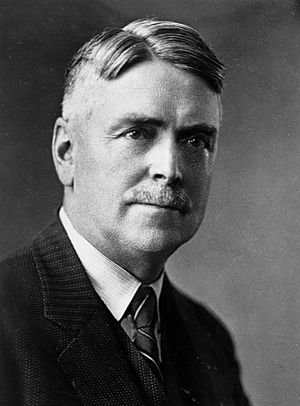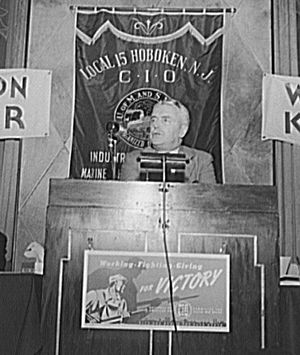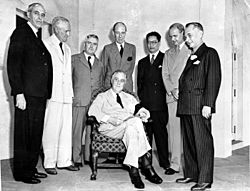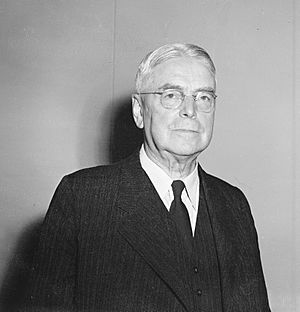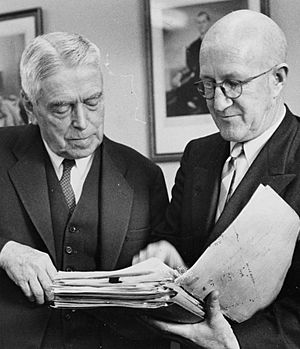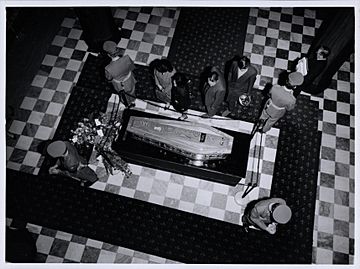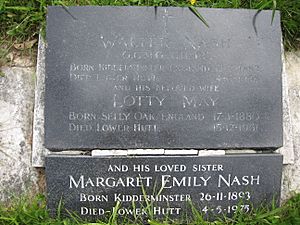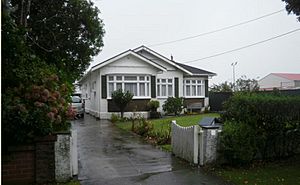Walter Nash facts for kids
Quick facts for kids
Walter Nash
|
|
|---|---|
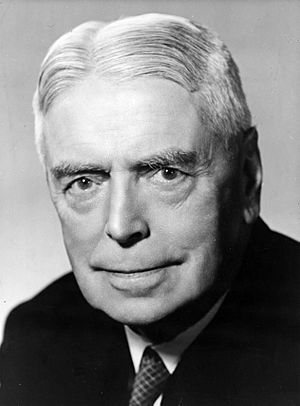
Portrait, (Catalan)
|
|
| 27th Prime Minister of New Zealand | |
| In office 12 December 1957 – 12 December 1960 |
|
| Monarch | Elizabeth II |
| Governor-General | Charles Lyttelton |
| Deputy | Jerry Skinner |
| Preceded by | Keith Holyoake |
| Succeeded by | Keith Holyoake |
| 14th Minister of Foreign Affairs | |
| In office 12 December 1957 – 12 December 1960 |
|
| Prime Minister | Himself |
| Preceded by | Tom Macdonald |
| Succeeded by | Keith Holyoake |
| 5th Leader of the Labour Party | |
| In office 17 January 1951 – 31 March 1963 |
|
| Deputy |
|
| Preceded by | Peter Fraser |
| Succeeded by | Arnold Nordmeyer |
| 27th Minister of Finance | |
| In office 6 December 1935 – 13 December 1949 |
|
| Prime Minister |
|
| Preceded by | Gordon Coates |
| Succeeded by | Sidney Holland |
| 35th Minister of Customs | |
| In office 6 December 1935 – 13 December 1949 |
|
| Prime Minister |
|
| Preceded by | Gordon Coates |
| Succeeded by | Charles Bowden |
| 14th President of the Labour Party | |
| In office 24 April 1935 – 14 April 1936 |
|
| Vice President | James Roberts |
| Preceded by | Tim Armstrong |
| Succeeded by | Clyde Carr |
| Member of the New Zealand Parliament for Hutt |
|
| In office 18 December 1929 – 4 June 1968 |
|
| Preceded by | Thomas Wilford |
| Succeeded by | Trevor Young |
| Personal details | |
| Born | 12 February 1882 Kidderminster, Worcestershire, England |
| Died | 4 June 1968 (aged 86) Lower Hutt, New Zealand |
| Nationality | New Zealand |
| Political party | Labour |
| Spouse |
Lotty May Eaton
(m. 1906; died 1961) |
| Children | 4 |
| Relatives | Stuart Nash (great-grandson) |
| Signature | |
Sir Walter Nash (12 February 1882 – 4 June 1968) was an important New Zealand politician. He served as the 27th prime minister of New Zealand from 1957 to 1960. He was part of the New Zealand Labour Party for a very long time, right from when it started.
Walter Nash was born in England and moved to New Zealand in 1909. He joined the Labour Party early on. His beliefs, like being a Christian and wanting peace, guided him into politics. He was a great organiser and administrator, even if he sometimes found it hard to make quick decisions.
Nash was elected to Parliament in 1929. He represented the Hutt area for 38 years. This makes him one of New Zealand's longest-serving Members of Parliament (MPs). In 1935, he became the Minister of Finance. He helped New Zealand's economy during the Great Depression and World War II. He was the Minister of Finance for 14 years, which is the longest time anyone has held that job.
After Peter Fraser died, Nash became the leader of the Labour Party in 1951. He was a moderate leader. Some people criticised him for not fully supporting workers during the 1951 waterfront strike. He was also criticised for not taking stronger action when Māori rugby players were excluded from a tour to South Africa in 1960.
In 1957, the Labour Party won the election, and Nash became Prime Minister. His government's "Black Budget" in 1958 raised taxes on things like beer and tobacco. This was done to fix a money problem, but it made many people unhappy. Labour lost the 1960 election because of this.
Nash was very active in international affairs. He traveled a lot as Prime Minister, working on trade and helping other countries. He was 78 when he left office, making him New Zealand's oldest Prime Minister. He died in 1968 at 86, still serving as an MP. He had a special state funeral.
Contents
Early Life and Moving to New Zealand
Walter Nash was born on 12 February 1882 in Kidderminster, England. He did well at school and won a scholarship. But his family could not afford the extra costs, so he could not go. Nash started working as a clerk.
In 1906, Nash married Lottie May Eaton and opened a shop. He was very involved in his community. He joined many clubs and societies. He also went to night school to learn more.
By 1908, his family faced difficulties. His wife and son were sick, and a daughter died at birth. His business also struggled because of an economic recession. The family decided to move to New Zealand.
They arrived in Wellington in May 1909. Nash became a secretary for a tailor. His wife had two more sons. Nash's strong Christian faith and belief in socialism grew stronger. He believed that being a Christian and a socialist went together. He also became a pacifist, meaning he believed in peace and was against war.
During World War I, Nash gave speeches about his pacifist beliefs. He called for understanding with German and Austrian Christians. Even though many people in New Zealand were against Germans, Nash let a German person stay at his home. Because he was openly a pacifist, the police watched his mail.
Nash's money problems continued. He moved to Palmerston North and then started a tailoring company in New Plymouth. But this business also did not do well.
Starting His Political Journey
Walter Nash had been briefly involved with the first Labour Party in 1910. But his money troubles stopped him from being very active. In 1918, he helped start the New Plymouth branch of the modern Labour Party. He became very active as the secretary and main organiser for the party in the 1919 local elections.
Labour wanted to borrow money to build council houses. They also wanted to set up a city milk supply. Nash ran for the borough council himself but did not win. The next year, Nash was elected to the Labour Party's national executive.
In 1920, Nash and his wife traveled to Europe. They went to different socialist meetings. When they returned to New Zealand in 1921, Nash was fined for bringing in "seditious literature." This meant he brought in writings that the government thought might cause trouble.
Despite this, Nash was one of the more moderate members of the Labour Party. In 1922, he was elected national secretary of the Labour Party. When he took this job, the party had a debt of £220. Nash helped the party pay off its debts. He is often given credit for making the Labour Party a strong and organised group.
Nash worked hard to get more people to join the party. Membership grew from 21,000 in 1919 to 45,000 in 1925. He also set up a main office to help coordinate party activities and election campaigns. This was a very important step for Labour to become a major political party in New Zealand.
Nash also got involved in local politics in Wellington. He ran for the Wellington City Council in 1927 but did not win. Two years later, he ran for Mayor of Wellington but was defeated.
Serving in Parliament
| New Zealand Parliament | ||||
| Years | Term | Electorate | Party | |
| 1929–1931 | 23rd | Hutt | Labour | |
| 1931–1935 | 24th | Hutt | Labour | |
| 1935–1938 | 25th | Hutt | Labour | |
| 1938–1943 | 26th | Hutt | Labour | |
| 1943–1946 | 27th | Hutt | Labour | |
| 1946–1949 | 28th | Hutt | Labour | |
| 1949–1951 | 29th | Hutt | Labour | |
| 1951–1954 | 30th | Hutt | Labour | |
| 1954–1957 | 31st | Hutt | Labour | |
| 1957–1960 | 32nd | Hutt | Labour | |
| 1960–1963 | 33rd | Hutt | Labour | |
| 1963–1966 | 34th | Hutt | Labour | |
| 1966–1968 | 35th | Hutt | Labour
|
|
Nash ran for election in the Hutt area in 1925 and 1928. He finally won in a special election in 1929. He served as the MP for Hutt for 13 terms, for over 38 years. This makes him the 4th longest-serving MP in New Zealand's history.
As soon as he entered Parliament, Nash became one of Labour's main spokesmen on money matters. By 1932, he was a senior finance spokesman. After becoming an MP, Nash built a modest house in Hutt. He lived there for the rest of his life.
Minister of Finance: Helping New Zealand's Economy
When Labour won the 1935 election, Michael Joseph Savage became Prime Minister. Nash was made Minister of Finance. He also held other smaller roles, like Minister of Customs and Minister of Social Security. He was the third most important person in the government.
Nash was Minister of Finance for the next 14 years. This is the longest time anyone has held that job continuously. When Nash became Finance Minister, New Zealand's economy was in a bad state. He worked very hard to improve things.
He brought back a special land tax. This tax helped the government get more money for its spending. He also oversaw the government taking control of the Reserve Bank of New Zealand. This meant the government had more power over the country's money.
Rising prices for New Zealand's exports helped the government. They were able to put their election promises into action. These changes included giving back wage cuts, increasing pensions, and guaranteeing prices for farmers.
In 1936, Nash went to England for trade talks. He wanted to get better deals for New Zealand's goods. He also visited other European cities like Berlin and Moscow to see if New Zealand could trade with them. He even made a trade deal with Germany to sell butter there.
When he returned, Nash faced arguments within the Labour Party. Some people thought his economic plans were too moderate. But Nash had the support of Prime Minister Savage and Peter Fraser. He also became responsible for putting Labour's social security plan into action. This plan helped people in need.
After Labour won the 1938 election, New Zealand faced another money crisis. Nash decided to introduce controls on money exchange and imports. He said this would help New Zealand keep its living standards. It would also make sure the country lived within its income.
Nash's plans were criticised by other countries. They thought it would hurt their trade with New Zealand. In 1939, Nash went back to Britain to get loans. He also tried to reassure the British government that their exports would not be harmed. He managed to get a loan of £16 million, but the terms were very strict.
Soon after, World War II began. The British government quickly wanted to buy all of New Zealand's meat and dairy products. This helped New Zealand's money situation improve quickly. The country was then able to pay back the loan from Britain.
The first years of World War II were hard for the Labour Party. Prime Minister Savage was very ill. Another Labour MP, John A. Lee, strongly criticised the party's economic policy. Nash reluctantly changed his pacifist views during World War II. He believed this war was necessary because of Germany's actions.
Taxes were raised a lot to pay for the war. Income tax went up significantly. Nash also extended social security payments for the poor. Pension payments were raised, and the government helped pay for basic goods like bread and sugar.
From May to September 1941, Nash was acting Prime Minister. This was when Fraser visited New Zealand troops in North Africa. During this time, Nash helped reduce New Zealand's debt to other countries.
In 1942, Nash became New Zealand's representative in the United States. But he often returned to Wellington to do his job as Minister of Finance. Nash was known for being difficult to work for. He liked to keep all the files and make all the decisions himself.
After the war, Nash attended meetings to create the United Nations. He also suggested that New Zealand join the International Monetary Fund. He represented New Zealand at other big international meetings about rebuilding after the war.
By the 1949 election, the Labour government was not very popular. There were strikes and prices were rising. The National Party won the election.
Leading the Opposition
After the 1949 election, Peter Fraser died. Walter Nash was chosen as the new leader of the Labour Party. He was the only person who put his name forward for the job.
The first big challenge for Nash was the 1951 New Zealand waterfront dispute. This was a major strike that hurt the economy. Labour's position was seen as unclear. Some workers felt they didn't get enough support. But businesses thought Labour was too soft on the unions. Nash famously said, "We are not for the waterside workers, and we are not against them." People made fun of him for this for many years.
Labour lost badly in the special election that the Prime Minister, Sidney Holland, called in 1951. This big loss put pressure on Nash's leadership. As the Leader of the Opposition, Nash was not seen as a great success. He was good at organising, but not at inspiring people like previous leaders. He was also seen as too slow to make decisions.
In 1954, some MPs tried to remove Nash as leader. Nash was 71 years old at the time. But with support from unions and party branches, Nash kept his leadership.
Despite the challenges, Nash led Labour well into the 1954 election. They gained five seats and almost matched the National Party in votes. This helped Nash keep his leadership. New Labour MPs also brought new energy to the party.
As the National government became less popular, Labour gained strength. In the 1957 election, Labour won by a small margin. At 75 years old, Nash became Prime Minister.
Prime Minister: Leading New Zealand
As Prime Minister, Nash also took on the roles of Minister of Foreign Affairs and Minister of Maori Affairs. When the new government took office, they found New Zealand's financial situation was much worse than they thought.
Nash decided that strong actions were needed. These actions led to the "Black Budget" in 1958. This budget, presented by Arnold Nordmeyer, the new Minister of Finance, included big tax increases. It made many people angry. The National Party said Nash and Nordmeyer were making the problem seem worse than it was. The taxes on petrol, cigarettes, and beer made Nash's government seem mean.
Nash was often out of the country, traveling. This left Nordmeyer and other ministers to defend the government's policies alone.
Nash became very focused on international affairs. He believed that world peace was a very important issue. He wanted to help guide the world towards more peaceful ways. Other world leaders respected his knowledge of global issues.
Nash worked to change trade agreements from 1932. He was also a strong supporter of the Colombo Plan. This plan provided aid and help to developing countries. Nash visited many projects funded by the Colombo Plan in Asia. He believed in helping people in need.
The Nash government also helped Western Samoa become independent. Nash had shown interest in Samoa before. Samoa gained its independence in 1962.
In 1960, Nash was criticised for not acting on a rugby tour to South Africa. South Africa had an apartheid government, which meant it had strict racial segregation. The South Africans insisted that the New Zealand team should not include any Māori players. Many New Zealanders signed a petition against the tour.
Nash had always spoken out against apartheid. So, people expected him to support the protesters. But he refused to get involved. He said it was up to the rugby authorities to decide. He argued that expecting Māori to visit South Africa would expose them to discrimination. He also said that shunning apartheid would only make things worse in South Africa.
The decision to exclude Māori from the team was widely criticised in other countries. It hurt New Zealand's international reputation. After the tour, Nash told the Rugby Union that in future tours, South Africa should accept Māori players. New Zealand did not tour South Africa again until 1970, when Māori players were included.
Nash did not appoint a Māori person as Minister of Māori Affairs. Instead, he took the role himself, with an associate minister, Eruera Tirikatene. Nash believed that the Prime Minister holding the Māori Affairs role showed the government's commitment to Māori people. Nash often spoke on marae, saying that "there were no inferior or superior races."
Nash was concerned about how Māori land was being managed. He appointed Jack Hunn to look into Māori assets. This led to the 'Hunn report' in 1960, which looked at the problems and future of Māori. Nash was busy with the upcoming election and did not read the report until after the election. The report was later used by the next government.
In the 1960 election, Labour was defeated by the National Party. Nash became Leader of the Opposition again. He is the only Labour leader to have been Leader of the Opposition both before and after being Prime Minister.
Later Life and Retirement
By late 1960, Nash was nearly 80 years old. He admitted that his hearing and memory were not as good. His wife's death in 1961 also affected him deeply. People started asking him to retire more often.
But Nash did not want to step down. He wanted to continue his work. He also did not want Arnold Nordmeyer to take over as leader. Nash had planned to retire in 1962, making way for his deputy, Jerry Skinner. But Skinner died suddenly just before the conference. Nash had to change his plans.
Another deputy, Fred Hackett, also died before Nash retired. In February 1963, Nash finally retired as leader of the Labour Party. Nordmeyer was chosen to replace him. Nash was the first Labour leader who did not die while still in office.
Nash was one of the few New Zealand prime ministers who stayed in Parliament for a long time after losing power. He became known as the "grand old man" of New Zealand politics. He continued to speak about international affairs and traveled regularly.
In 1964, at 81 years old, he traveled to Antarctica. He flew to McMurdo Sound in an American research plane. Newspapers reported that he was the oldest man to have reached the South Pole.
Nash opposed military involvement in the Vietnam War. He became active in the protest movement against the war. He spoke at many events at universities, where he was well received. Nash had been unpopular with some people because of his actions during the 1951 waterfront dispute and the 1960 rugby tour. But his strong opposition to the Vietnam War helped improve his reputation.
Death and State Funeral
In late 1966, Nash spent three weeks in hospital. In May 1968, he had a heart attack. He died on 4 June 1968. People praised his contributions during his career, especially as Minister of Finance.
His body lay in state at Parliament. He was given a state funeral, the first since Peter Fraser's in 1950. The funeral was held at St James' Church of England in Lower Hutt. It was the first funeral in New Zealand to be shown on television. He was buried in Karori Cemetery next to his wife.
Money was raised to build a children's ward at a hospital in Vietnam as a memorial to him. This matched his idea that New Zealand should send "hospitals rather than artillery" to Vietnam.
When he died, Nash was still an MP. He was 86 years old, making him possibly the oldest person to be a serving New Zealand MP. His death led to a special election, which was won by Trevor Young.
Awards and Recognition
In 1935, Nash received the King George V Silver Jubilee Medal. In 1946, he became a member of the Privy Council. He was appointed a Member of the Order of the Companions of Honour in 1959. In 1965, he was made a Knight Grand Cross of the Order of St Michael and St George. It took him two years to decide if he would accept a knighthood. He accepted after talking with his party.
In 1957, he also received the highest award from the Scout Association of Japan, the Golden Pheasant Award. In 1963, he was given an honorary Doctorate of Laws by Victoria University of Wellington.
Places Named After Walter Nash
Many streets and public places have been named after Walter Nash. These are in various towns in New Zealand and in his birthplace of Kidderminster, England. Some examples include:
- Nash Road, Mount Roskill, Auckland
- In Taitā, Lower Hutt:
- Nash Street
- Walter Nash Centre
- Walter Nash Park
- Walter Nash Stadium
- Walter Nash Avenue, Kawerau
- Nash Street, New Plymouth
- Walter Nash Place, Whanganui
- Walter Nash Road East, Kidderminster
About His Personal Life
Walter Nash loved cricket. He played for a village cricket club in England. He was very good with numbers and could remember many cricket scores. When he was young, Nash was interested in Christian theology. He went to Anglican church services all his life. He believed in religious tolerance and that Christianity was not the only true religion.
From the 1930s, he was a patron or president of many clubs and societies. These included sports clubs like tennis, cricket, and cycling. He also supported groups like Boy Scouts and the Red Cross.
He met his wife, Lotty May Eaton, at a post office where she worked. Lotty was more lively than Walter. She was fun to be around and a good hostess. They had a son, then a daughter who died soon after birth. After moving to New Zealand, they had two more sons.
Nash loved to read. He was often seen with a book in his hand during his free time. He did not like swimming, but he would read while his wife swam.
His great-grandson, Stuart Nash, also became a Member of Parliament.
Images for kids
See also
 In Spanish: Walter Nash para niños
In Spanish: Walter Nash para niños


